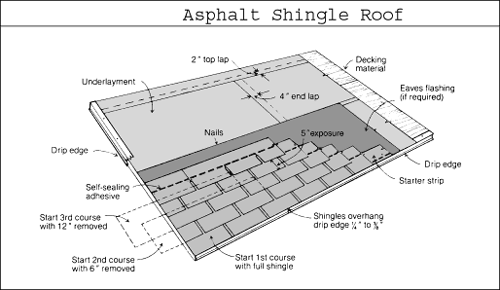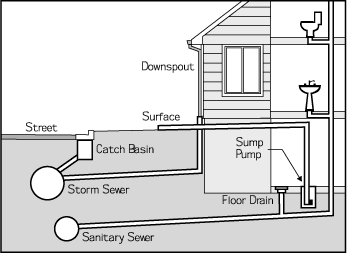Search This Blog
Wednesday, October 9, 2013
Monday, June 10, 2013
Drywall Inspection in Brevard County Florida
Why Should You Have A Drywall Inspection
There are many reasons why you should have a drywall inspection in your home or condo. Problems can lurk just beneath the surface, and cause a variety of health concerns and hide growing problems in your home. These issues can range from mold contamination, termites or even Chinese drywall contamination. A thorough drywall inspection can prevent damage, and prevent health problems for you and your family.Chinese Drywall Call (321)704-3396 to see what we can do for you!
Home owners who fail to have their drywall inspected, may discover too late that their home is effected and will be burdened with the costly repairs themselves. Have your drywall inspected today to ensure your home is void of Chinese drywall.
Mold
Mold can grow anywhere moisture gathers. In Florida, that can be around air ducts, water pipes, and many other hidden locations. The presence of mold can signal a leak in plumbing, a window or even your roof. A proper drywall inspection can insure that your home is safe from these potential hazard, and that your investment and family are protected.Termites
Termites can hide behind drywall devouring your home from within. A proper drywall inspection can help prevent damage before it becomes a costly nightmare by detecting infestations before they grow out of control.Choose The Best
At Brevard Home Inspections we ensure your peace of mind by following strict and thorough drywall inspection procedures. Using the latest in technology and thermal imaging equipment, we examine your drywall both inside and out.Your home is too important to trust to inexperienced, or untrained drywall inspectors. Gain the peace of mind you deserve, contact Brevard Home Inspections, Inc. to have your drywall inspected. Serving Melbourne, Cocoa, Palm Bay, Satellite Beach and all of the Space-coast of Florida
New Home Inspection Brevard County Florida
New Home Inspection
Reasons For A New Home Inspection
Buying a new house is likely one of, if not the largest purchase decision you’ll ever make. The whole process is fraught with emotion and stress. A professional home inspection will substantially reduce the risk for your large investment in a new home. It just makes sense to learn as much as you can about the quality of your new home, before signing off on everything.
Address New Home Inspection Issues During the Building Process
Building a new home is a tremendously complex endeavor. It involves many people, usually split up into sub-contractor groups, each working on different parts and systems of the house. Even for the best builders, its nearly impossible to complete this process without missing something. Maybe its a plumbing fixture that didnt get tested for leaks, maybe its an electrical box that isnt working, or any one of dozens of minor problems that can easily be overlooked in such a major undertaking. We will find such problems while it is still early enough for you to bring them up with the builder and have them corrected before you sign-off and start moving in.For the relatively small cost, a professional inspection of your new dream home can pay big dividends in peace of mind and getting any problems identified and corrected before they can become an unpleasant surprise.
Location:
Brevard, FL, USA
Septic System Inspection Brevard County Florida
Septic System Information
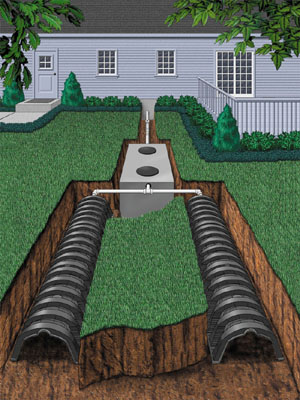 Everything that goes down any of the drains in the house (toilets, showers, sinks, laundry machines) travels first to the septic tank. The septic tank is a large-volume, watertight tank which provides initial treatment of the household wastewater by intercepting solids and settleable organic matter before disposal of the wastewater (effluent) to the drain field.
Everything that goes down any of the drains in the house (toilets, showers, sinks, laundry machines) travels first to the septic tank. The septic tank is a large-volume, watertight tank which provides initial treatment of the household wastewater by intercepting solids and settleable organic matter before disposal of the wastewater (effluent) to the drain field.
Function of the Septic System Tank How Long Liquids Must Remain In Tank Solids Storage Anaerobic Decomposition Flow Into And Out Of The Tank Effluent Filter Flow Buffering Microbes in Septic Tanks Digest, Dissolve, and Gasify Complex Organic Wastes.
FUNCTION OF THE SEPTIC SYSTEM TANK
While relatively simple in construction and operation, the septic system tank provides a number of important functions through a complex interaction of physical and biological processes. The essential functions of the septic system tank are to: receive all wastewater from the house separate solids from the wastewater flow cause reduction and decomposition of accumulated solids provide storage for the separated solids (sludge and scum) pass the clarified wastewater (effluent) out to the drain field for final treatment and disposal.Primary Treatment As stated, the main function of the septic system tank is to remove solids from the wastewater and provide a clarified effluent for disposal to the drain field. The septic tank provides a relatively quiescent body of water where the wastewater is retained long enough to let the solids separate by both settling and flotation. This process is often called primary treatment and results in three products: scum, sludge, and effluent.
Scum: Substances lighter than water (oil, grease, fats) float to the top, where they form a scum layer. This scum layer floats on top of the water surface in the tank. Aerobic bacteria work at digesting floating solids.
Sludge: The "sinkable" solids (soil, grit, bones, unconsumed food particles) settle to the bottom of the septic system tank and form a sludge layer. The sludge is denser than water and fluid in nature, so it forms a flat layer along the tank bottom. Underwater anaerobic bacteria consume organic materials in the sludge, giving off gases in the process and then, as they die off, become part of the sludge.
Effluent: Effluent is the clarified wastewater left over after the scum has floated to the top and the sludge has settled to the bottom. It is the clarified liquid between scum and sludge. It flows through the septic tank outlet into the drain field.
HOW LONG LIQUIDS MUST REMAIN IN SEPTIC SYSTEM TANK Effective volume: The floating scum layer on top and the sludge layer on the bottom take up a certain amount of the total volume in the tank. The effective volume is the liquid volume in the clear space between the scum and sludge layers. This is where the active solids separation occurs as the wastewater sits in the septic system tank.
Retention time: In order for adequate separation of solids to occur, the wastewater needs to sit long enough in the quiescent conditions of the septic system tank. The time the water spends in the septic system tank, on its way from inlet to outlet, is known as the retention time. The retention time is a function of the effective volume and the daily household wastewater flow rate:
Retention Time (days) = Effective Volume (gallons)/Flow Rate (gallons per day) A common design rule is for a tank to provide a minimum retention time of at least 24 hours, during which one-half to two-thirds of the tank volume is taken up by sludge and scum storage. Note that this is a minimum retention time, under conditions with a lot of accumulated solids in the tank. Under ordinary conditions (i.e., with routine maintenance pumping) a tank should be able to provide two to three days of retention time. As sludge and scum accumulate and take up more volume in the tank, the effective volume is gradually reduced, which results in a reduced retention time. If this process continues unchecked-if the accumulated solids are not cleaned out (pumped) often enough-wastewater will not spend enough time in the tank for adequate separation of solids, and solids may flow out of the septic system tank with the effluent into the drain field. This can result in clogged pipes and gravel in the drain field, one of the most common causes of septic system failure.
SOLIDS STORAGE In order to avoid frequent removal of accumulated solids, the septic tank is (hopefully) designed with ample volume so that sludge and scum can be stored in the tank for an extended period of time. A general design rule is that one-half to two-thirds of the tank volume is reserved for sludge and scum accumulation. A properly designed and used septic system should have the capacity to store solids for about five years or more. However, the rate of solids accumulation varies greatly from one household to another, and actual storage time can only be determined by routine septic tank inspections.
ANAEROBIC DECOMPOSITION While fresh solids are continually added to the scum and sludge layers, anaerobic bacteria (bacteria that live without oxygen) consume the organic material in the solids. The by-products of this decomposition are soluble compounds, which are carried away in the liquid effluent, and various gases, which are vented out of the tank via the inlet pipe that ties into the house plumbing air vent system. Anaerobic decomposition results in a slow reduction of the volume of accumulated solids in the septic tank. This occurs primarily in the sludge layer but also, to a lesser degree, in the scum layer. The volume of the sludge layer is also reduced by compaction of the older, underlying sludge. While a certain amount of volume reduction occurs over time, sludge and scum layers gradually build up in the tank and eventually must be pumped out.
FLOW INTO AND OUT OF THE SEPTIC SYSTEM TANK The inlet and outlet ports of the tank are generally equipped with devices such as baffles, concrete tees, or in more recent years, sanitary tees (T-shaped pipes with one short and one long leg). Inlets The inlet device dissipates the energy of the incoming flow and deflects it downwards. The vertical leg of the tee extends below the liquid surface well into the clear space below the scum layer. This prevents disturbance of the floating scum layer and reduces disruptive turbulence caused by incoming flows. The inlet device also is supposed to prevent short-circuiting of flows across the water surface directly to the outlet. The upper leg of the inlet should extend well above the liquid surface in order to prevent floating scum from backing up into, and possibly plugging, the main inlet pipe. The open top of the inlet tee allows venting of gases out of the tank through the inlet pipe and fresh air vents of the household plumbing.
Outlets The outlet device is designed to retain the scum layer within the tank. A sanitary tee can be used with the lower leg extending below the scum layer. The elevation of the outlet port should be 2 to 3 inches below the elevation of the inlet port. This prevents backwater and stranding of solids in the main inlet pipe during momentary rises in the septic system tank liquid level caused by surges of incoming wastewater.
Typical inlet/outlet tees
Gas Deflection Baffle
Gases are produced by the natural digestion of sludge at the bottom of the tank, and particles of sludge can be carried upward by these rising gases. Some tanks have a gas deflection baffle, which prevents gas bubbles (to which solid particles often adhere) from leaving the tank by deflecting them away from the outlet and preventing them from entering the drain field.
THE EFFLUENT FILTER In newer systems, there is often an effluent filter: one of the significant improvements in septic tank design in decades. They range from 4 to 18 inches in diameter. As we have described, the most serious problem with septic systems is the migration of solids, grease, or oil into the drain field, and the filter is effective in preventing this. A filter restricts and limits passage of suspended solids into the effluent. Solids in a filtered septic system effluent discharge are significantly less than those produced in a non-screened septic system.
FLOW BUFFERING The septic system tank also provides a buffering of flows between the house and the drain field. Large surges from the household, such as toilet flushing or washing machine drainage, are dampened by the septic system tank so that the flows leaving the tank and entering the drain field are at substantially lower flow rates and extend over a longer period of time than the incoming surges.
MICROBES IN SEPTIC SYSTEM TANKS DIGEST, DISSOLVE, AND GASIFY COMPLEX ORGANIC WASTES In 1907, W. P. Dunbar conducted tests on the decomposition of vegetable and animal matter in septic tanks. He stated, "The author has investigated the subject by suspending in septic tanks a large number of solid organic substances, such as cooked vegetables, cabbages, turnips, potatoes, peas, beans, bread, various forms of cellulose, flesh in the form of dead bodies of animals, skinned and unskinned, various kinds of fat, bones, cartilage, etc., and has shown that many of these substances are almost completely dissolved in from three to four weeks. They first presented a swollen appearance, and increased in weight. The turnips had holes on the surface, which gradually became deeper. The edges of the cabbage leaves looked as though they had been bitten, and similar signs of decomposition were visible in the case of other substances. Of the skinned animals, the skeleton alone remained after a short time; with the unskinned animals the process lasted rather longer. At this stage I will only point out that the experiments were so arranged that no portion of the substances could be washed away; their disappearance was therefore due to solution and gasification."
Home Inspection Report by Brevard Home Inspection 321-704-3396
Home Inspection Report
Brevard Home Inspections Pricing
Brevard Home Inspections Pricing
Brevard Home Inspection
| 1500 sq feet or less | $250 |
| 1501-2000 sq feet | $300 |
| 2001-2500 sq feet | $350 |
| 2501-3000 sq feet | $400 |
| 3001-3500 sq feet | $450 |
| 3500-4000 sq feet | $500 |
| Over 4000 sq feet | Call for quote |
| Add $50.00 for a crawl space | |
| Add $50.00 for a pool | |
| Add $50.00 for sprinklers | |
| Bundling another inspection like a wind mitigation or 4-point inspection with your home inspection? Ask about our package prices. | |
203(k) Inspections
| If the rehab is: | The fee will be: |
| Less than $7,500 | $400.00 |
| Between $7,501 and $15,000 | $500.00 |
| Between $15,001 and $30,000 | $600.00 |
| Between $30,001 and $50,000 | $700.00 |
| Between $50,001 and $75,000 | $800.00 |
| Between $75,001 and $100,000 | $900.00 |
| Over $100,000.00 | $1,000.00 |
| Any applicable mileage will be added to the appropriate fee. | |
| Draw inspections are $150 each (plus applicable mileage). | |
Manufactured/Modular Home Inspections
| Foundation | $350.00* |
| Pre-Cert | $350.00 |
| Set-up/Delivery | $150.00 |
| Final | $150.00 |
| FHA/VC Compliance | $150.00 |
| Structural on Additions | $300.00 |
| Foundation Plans | $450.00 and up (call for quote) |
| *Ask about our Foundation Discount program. | |
Site-Built Building Inspections
| Structural | $300.00 |
| FHA/VC Compliance | $150.00 |
| Repair Inspection | $150.00 |
| Insurance Draw | $150.00 and up (call for quote) |
| Home Inspection | $250.00 and up (see “About Home Inspections” at top of page) |
| Wind Mitigation | $125.00 |
| 4-point Insurance | $150.00 |
| 203(k) Feasibility Study | $400.00 |
| 203(k) Consultation | $400.00 and up (see “About 203k Inspections” at top, or call for quote) |
| 203(k) Draw | $150.00 |
| Commercial Building Inspection | $400.00 and up (call for quote) |
Florida Home Inspector George Pembleton,
Florida Home Inspector George Pembleton, Professional, Certified in Brevard and Indian River Counties in Central Florida
Florida Home Inspector George Pembleton: "Author"If you are like most people, chances are you invested a great deal of time in the search for your new home. Whether as a family, a couple or as a single person, you have had a good idea all along of exactly what you wanted your dream home to look like, inside and out. But finding that home has probably been a long and arduous process, most likely taking months, sometimes even years and looking at countless homes, before finally finding The home for you. Congratulations!
Now comes the time for the real investment, the investment of money and the many years of mortgage payments before your home is finally actually yours and you can celebrate all your hard work and investment of time and money in your home. As you already know, your home is probably going to be the largest single investment of money you will make in your lifetime.
So, now you have finally found your dream home, you've had it inspected or are getting ready to have it inspected, the mortgage is all set up and you are ready to sign that mortgage on the dotted line and take the keys to your brand new dream home.
Not so fast...
Who is Inspecting Your New Home Before You Buy It?
Who did you choose to do your home inspection? This will probably surprise you, but choosing the person that will be inspecting your new home before you buy it, is probably going to end up being one of the most important decisions you will ever make.Don't let your dream home turn into a nightmare! Make sure you have your home professionally inspected by George Pembleton of Brevard Florida Home Inspector Services before you buy it, to make sure it is thoroughly inspected by a certified professional that truly cares about the quality of his inspections.
You can easily see how beautiful your home looks from the outside and on the inside. New landscaping, new flooring here, new paint there and that nice new door or countertop all make it look perfect. But the truth is that even a brand new home can have minor to serious problems that can cost you a staggering amount of money to fix in the future... after the damage has been done years later from undetected home construction problems that existed at the time of purchase.
Trust your home inspections to George Pembleton (BrevardHomeInspections.com) where our motto is, "Before you invest, let us inspect!" George has over 12 years of experience in the construction field serving as Project Coordinator, Construction Manager, Assistant Director of Facilities, Regional Director of Construction, and an Electrical Contractor. George is certified by the National Association for Certified Home Inspectors (NACHI).
If you think we are exaggerating the importance of having your home inspected by a fully licensed, certified and highly qualified home inspector, please believe us, we are not. Home inspections are a very serious business before purchasing a new home. Horror stories abound all over, of people that have paid hundreds of thousands of dollars on a home, only to find major issues costing tens and possibly even hundreds of thousands of dollars to fix. These stories happen almost every day.
In fact, there is now a reality television show that just deals with real home inspections. On a recent episode it featured a couple who had spent almost $300,000 on a new home after having it professionally inspected, only to find such serious structural damage shortly afterwards, that it was initially thought they would have to tear the entire home down and rebuild it. Luckily they were able to salvage their home, but only due to the expertise of the inspector and the contractors that took on the challenge.
This is of course a very extreme situation, but serious and almost as serious issues come up all the time after home purchases that were based on inadequate home inspector s. At Brevard Home Inspection Services, we do four main types of home inspections.
Pre-Purchase Home Inspections in Melbourne, Palm Bay, Brevard and Indian River
Our pre-purchase inspections are a complete, visual non-invasive inspection of the home, but not technically exhausting unless issues are found that need a further look. The roof, attic, exterior, foundation, doors and windows, floors, steps, plumbing system, electrical system, heating and A/C system will all be carefully inspected. Also the site will be inspected for proper drainage and any other issues. You will have your inspection report online within 24 hrs. and it will list the deficiencies noted during the inspection, pictures of any deficiencies found, and a recommendation on any needed repairs or further inspections needed.Wind Mitigation Florida Home Inspector in Brevard and Indian River Counties
Wind Mitigation is a visional inspection roof and basic structure consisting of what building code was used to install the roof covering, roof geometry, roof deck attachment, roof to wall attachment, gable bracing (when applicable), what building code was used to build the structure, wall construction type, whether it has a SWR (secondary water resistance), and opening protection. All openings must be protected by either shutters, high impact windows, and garage door approved by the state of Florida that is impact rated. This type and main reason for this inspection is for the benefit of the home owner to help lower their insurance costs. Most houses qualify for some discount but usually only the houses they have been built within the last few years will qualify for every discount. Without any these improvement the home owner will find his or her insurance extremely high.Seller's: Florida Home Inspector on Florida's Space Coast
A pre-sale inspection is done to find out if there are any repairs needed prior to putting a home on the market. This inspection report can be made available to all potential home buyers and realtors. We will also install a sign in your front yard to let everyone know your house has been inspected and is "Move in Certified and Ready to Move in".The are some major advantages to doing this, as follows:
- Any major repairs can be made ahead of time, thus giving the seller time to negotiate a fair cost to make the repairs
- Homes that are in good shape can demand top dollar, even in a down market
- Most people look for a home that is in "move in condition"
- Helps prevent deals from going sour in the eleventh hour when something unexpected is found
- Fifteen copies of the inspecction report are left on site for the potential buyers to review.
- Inspection report uploaded to a secure website so the public can see it online.
4 Point Insurance Home Inspection in Brevard County and Indian River County
We provide fast and accurate 4 Point Insurance Inspection for the insurance industry in Brevard and Indian River Counties. Our 4 Point Insurance Inspections consist of a visual inspection of the condition of the roof, electrical, heating & A/C systems and the plumbing system.Brevard Home Inspection Services is located in Indian Harbor, FL and is owned and operated by George Pembleton of Brevard Home Inspection. We proudly serve Brevard and Indian River Counties and provide service to home buyers and sellers, investors, real estate attorneys, banks, insurance companies and work with several real estate offices.
Contact Florida Home Inspector George Pembleton Today @ (321)704-3396 WHEN YOU NEED THE VERY BEST!

Brevard Home Inspections Springtime Maintenance Newsletter
Monthly Newsletter
April 2013
Springtime Maintenance Newsletter
Check Gutters and Downspouts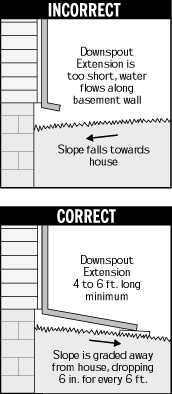 Newsletter: Gutters collect tremendous quantities of water from the roof and must deliver that water away from the foundation. Keep you downspouts extended at least 6 to 8 feet away from the foundation to a spot where the natural grade of the soil continues moving the water away.
Newsletter: Gutters collect tremendous quantities of water from the roof and must deliver that water away from the foundation. Keep you downspouts extended at least 6 to 8 feet away from the foundation to a spot where the natural grade of the soil continues moving the water away.If your area has underground storm sewers, make sure all downspouts are properly connected to the visible pipe fittings and that water flows into the storm sewer pipe during rainstorms. If this pipe backs up during a storm, it indicates that the storm sewer line is plugged or broken. Test the line by running a hose into the gutter. You can have this line cleaned by a sewer cleaner.
If dampness and seepage appear on basement walls near an underground storm sewer connection, a broken storm sewer line may be the cause. You can run water into the gutter during a dry spell; if moisture seeps into the basement, it indicates that the underground line is damaged. A sewer cleaner can evaluate and repair the line.
Keep gutters clean to prevent plugging and over-flowing of downspouts and storm sewer lines.
Gutters and Downspouts Newsletter
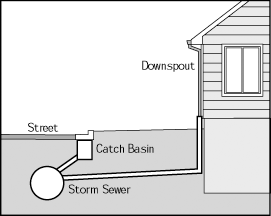 When it rains, your roof sheds a tremendous quantity of water that must be moved away from the foundation to protect the basement or crawl spaces. Gutters, downspouts and downspouts extensions serve this function.
When it rains, your roof sheds a tremendous quantity of water that must be moved away from the foundation to protect the basement or crawl spaces. Gutters, downspouts and downspouts extensions serve this function.Gutters may drain to the surface of your yard. They may be channeled underground to drain into the lower area of your yard. In urban areas, where storm systems collect rainwater; gutters may drain underground into the storm sewer system.
Newsletter Must Know/Must Do Roof, Gutters and Downspouts
- Inspect (or hire a professional to inspect) the roof and flashing twice a year.
Gutters must be cleaned and kept clear of debris. Som etimes twice a year is enough. At other times this must be done once a week, depending on the prevalence of leaves and other materials.
- Keep the drains of a flat roof clear of debris.
- Make sure all downspouts are directed away from the foundation.
- Downspouts routed underground must be cleared or repaired if they "back up."
- Check the roof for wear every few years. Plan for eventual replacement based on professional advice.
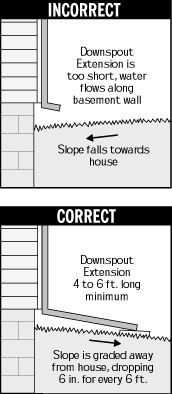 Proper grading around the house is your best protection against seepage into the basement that may cause expensive damage. (See figure on left) . When a home is built, workers dig the excavation several feet larger than the basement walls to allow for construction clearances. At the base of the hole, near the footing, they install a drain tile system and cover it with a small amount of gravel. After they apply a damp-proof coating to the wall, the hole is filled.
Proper grading around the house is your best protection against seepage into the basement that may cause expensive damage. (See figure on left) . When a home is built, workers dig the excavation several feet larger than the basement walls to allow for construction clearances. At the base of the hole, near the footing, they install a drain tile system and cover it with a small amount of gravel. After they apply a damp-proof coating to the wall, the hole is filled.Most of the hole around your basement is filled with soil from the site. This may contain gravel, rock, wood, paper, and unfortunately almost anything no longer useful for home construction. For the next 20 years, this soil and "stuff" settles around the basement walls. It settles quickly for the first few years and more slowly after that.
To divert surface water, the soil should pitch away from your home with a 1" pitch per linear foot for about 6 feet beyond the foundation. That is a 6" drop in 6 feet. You can measure this with a level and a straightedge held on top of the soil next to the foundation. At a minimum, the pitch should always have some slope for 6 feet beyond the foundation.
The soil should also be 6" below siding and wood trim to prevent water and insect damage. If wood siding touches the ground, water will wick up and rot the siding and framing. Also, the top course of block is less resistant to soil moisture because it probably lacks the moisture-proof coating applied to lower levels of the foundation wall.
To improve the grade, you have several options, depending on the landscape materials near your home.
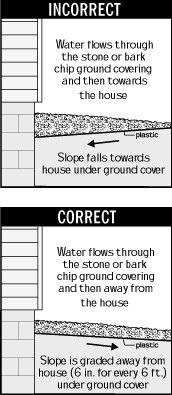 Bushes near the foundation, planted above the original foundation hole, often settle. If there is bare soil under the bushes, just add more soil. However, adding more than a few inches of soil can damage bushes by eliminating air from the roots. Check with a professional landscaper on the potential damage to your type of bushes. You may need to raise the bushes and fill under them.
Bushes near the foundation, planted above the original foundation hole, often settle. If there is bare soil under the bushes, just add more soil. However, adding more than a few inches of soil can damage bushes by eliminating air from the roots. Check with a professional landscaper on the potential damage to your type of bushes. You may need to raise the bushes and fill under them.If the area around the foundation has a planting bed or bushes with a ground cover, the soil under the ground cover must pitch away from the foundation. (See figure on right) . Dig through the ground cover in several areas to check the grade of the soil. To improve this situation, remove the ground cover and fill with soil. Then replace the ground cover.
You may wish to use a fabric weed barrier or black plastic over the soil. The weed barrier will stop weeds while allowing air and water movement - good for plants but not ideal for the basement.
Black plastic does the best job of deflecting water and protecting your basement, but it can be hard on plants. If you use black plastic, cut large holes in plants to improve access to moisture and air.
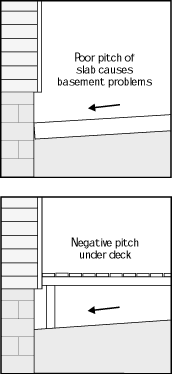 If there is sod next to the foundation, cut it with a sod cutter and fold it away from the foundation. Add soil, then lay the sod back in place. You could add soil directly over the sod, but that would require re-seeding, and the area will settle as the buried sod decomposes. Cover the sod only if it is in very poor condition or if you need a dramatic change in grade.
If there is sod next to the foundation, cut it with a sod cutter and fold it away from the foundation. Add soil, then lay the sod back in place. You could add soil directly over the sod, but that would require re-seeding, and the area will settle as the buried sod decomposes. Cover the sod only if it is in very poor condition or if you need a dramatic change in grade.For flower beds and bare soil, just add topsoil fill. When grading, don't use a light moss-type soil; it will settle too much and hold moisture. In areas where you will not be planting, you can use clay. In plating beds use a blended or brown planting soil or garden soil. This heavier mixture will not wash away into the yard.
Don't forget to grade areas under decks. You can use black plastic over the properly graded soil to deflect water and stop weeds. A thin cover of gravel or stone will hold down the plastic and make the area more attractive.
All hard surfaces as walks and driveways should also be pitched away from your foundation. The good news is that only a slight grade, as little as 1/4" per foot, is adequate for hard surfaces. (See figure on left).
Welcome To Brevard Home Inspections
Brevard Home Inspections
Google+
Welcome To Brevard Home Inspections
• All around the house• All about safety
• Accurate inspectors
• Small investment for future
• Safety comes first
• We care people
• Complete home inspector
• Protect home investment
• Serving health and safety
• A trusted name for home safety
• Working for cleaner and healthy environment
• A home analyst for your dream home
• We improve your healthy life
• Innovation solution for home
Buying a new home may be the biggest investment you’ll ever make. Having your new home professionally inspected by Brevard Home Inspections will give you piece of mind that your decision was a good one.
By detecting problems before they become yours, Brevard Home Inspections can save you thousands of dollars on items that may be corrected by the seller or builder.
Inspections by George Pembleton meet or exceed all ASHI standards and much more. At Brevard Home Inspections, we go to great lengths to provide you with the most comprehensive and thorough inspection that money can buy. We inspect all major systems in your home and report on each one individually. We enter ENTIRELY, every attic, every, crawl space, and every interior section of the home; and thoroughly inspect it.
Experienced and Professional
• Licensed and Insured
• State Certified in Wind Mitigation Inspections
• Easy to read same day inspection reports
• Available 7 days a week
• We exceed industry standards
• Superior customer service
• Certified Mold Inspector
• 10 years building construction experience
• M.A.A.R. Affiliate – Lock Box Access
Member of the National Association
of Certified Home Inspectors
Be Assured Of Your Home Inspections Decision!
All of our home inspections are done with your satisfaction and comfort in mind. We welcome you and your family to participate in the inspection. We will show you the things we find and explain the issues, in plain English. We also take the time to explain how the systems in your home work, how to maintain them and how to recognize problems when they first arise. We leave you with a maintenance checklist that will help you keep your home in great shape for years to come; and we are always available for questions after the inspection.
New Construction Inspections
Brevard Home InspectionsInspections is recognized as one of the leading New Construction experts in the field. We are Degreed Engineering Professionals with insightful knowledge of modern construction techniques and custom features.
Brevard Home Inspections offers Big Discounts with Double-TRUST:- Pre-Final Walk Through Inspection
- Pre-One Year Warranty Inspection
Double-Trust can save you hundreds on inspection fees and thousands on missed builder items. Be prepared for your builder walk-through meetings with our educational, on-site inspection where we show YOU what is going on with your home.
We are available to answer questions from 7AM to 10PM for your convenience – regardless of whether or not you choose Brevard Home Inspections for your home inspection.
From George Pembleton, President of Brevard Home Inspections: Good Luck, and thanks for visiting!
Brevard Home Inspections provides quality and thorough home inspections to the entire Space-coast areas of Florida. We are pleased to state that we are completely objective, as we do not work for realtors or solicit real estate offices for business. Furthermore, the majority of our business comes from past customer referrals, yellow page advertisements and our website. Whether you are buying or selling a home, call us today @ (321)704-3396 to see what we can do for you!
Mission
Our mission is to be Florida’s most preferred, most referred home inspection company with service that exceeds customer expectations…we will achieve this by educating the customer and ensuring complete customer satisfaction.
|
Coupon
Click on the coupon or link below to print a coupon redeemable for $25 off the price of a home inspection. (Please mention this when scheduling the inspection.)
| ||||
ASR Search Engine
ASR Search Engine
Google+
Showing all 5 results
- Sale!
4 point home Insurance Inspection
$ 200$ 175 Add to cart - Sale!
FHA/VC Compliance Inspection
$ 200$ 175 Add to cart - Sale!
Manufactured/Modular Home Inspections
$ 375$ 350 Add to cart - Sale!
New Home Inspection 1500SF
5.00 out of 5$ 300$ 275 Add to cart - Sale!
New Home Inspection 2000SF
5.00 out of 5$ 350$ 325 Add to cart
Subscribe to:
Comments (Atom)



